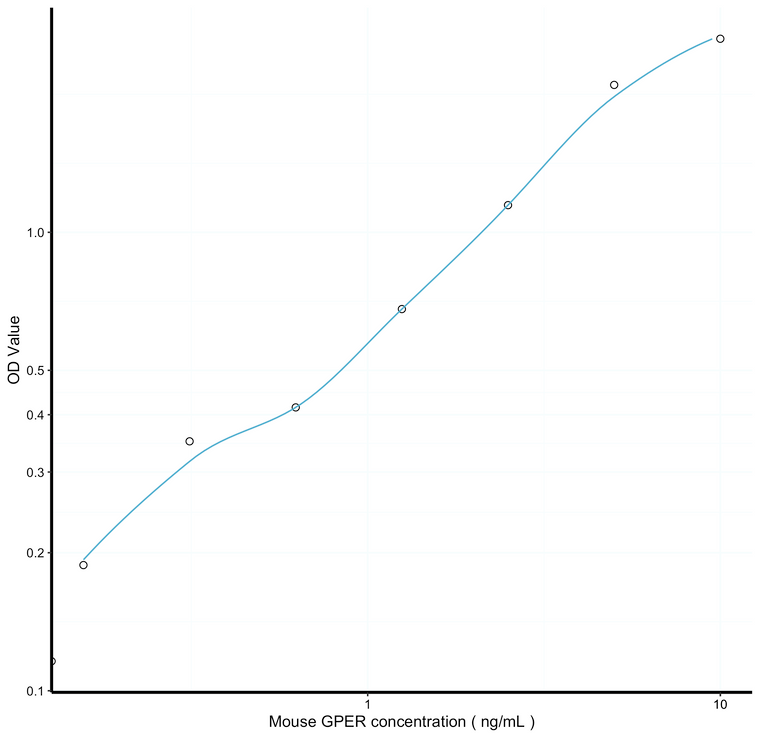| Applications: |
ELISA |
| Reactivity: |
Mouse |
| Note: |
STRICTLY FOR FURTHER SCIENTIFIC RESEARCH USE ONLY (RUO). MUST NOT TO BE USED IN DIAGNOSTIC OR THERAPEUTIC APPLICATIONS. |
| Sensitivity: |
0.054ng/mL |
| Detection Limit: |
0.156-10ng/mL |
| Short Description: |
This GPER Sandwich ELISA Kit is an in-vitro enzyme-linked immunosorbent assay for the measurement of samples in mouse cell culture supernatant, serum and plasma (EDTA, citrate, heparin). |
| Storage Instruction: |
Store the unopened kit in the fridge at 2-8°C for up to 6 months. Once opened store individual kit contents according to components table provided with the kit. |
| Assay Time: |
4.5 hrs |
| Gene Symbol: |
Gper1 |
| Gene ID: |
76854 |
| Uniprot ID: |
GPER1_MOUSE |
| Sample Type: |
serum, plasma, tissue homogenates or other biological fluids. |
| Tissue Specificity | Expressed in brain, heart, spleen, preadipocytes, mature adipocytes and primary hippocampal neurons. Expressed in neurons of the hippocampus, hypothalamic paraventricular nucleus (PVH), supraoptic nucleus (SON) and the median eminence. Expressed in the nucleus ambiguous (at protein level). Expressed in brain, pituitary gland, adrenal medulla, renal pelvis, ovary, endothelial cells, visceral fat tissues and islets of Langerhans. |
| Post Translational Modifications | Ubiquitinated.ubiquitination occurs at the plasma membrane and leads to proteasome-mediated degradation. N-glycosylated. |
| Function | G-protein coupled estrogen receptor that binds to 17-beta-estradiol (E2) with high affinity, leading to rapid and transient activation of numerous intracellular signaling pathways. Stimulates cAMP production, calcium mobilization and tyrosine kinase Src inducing the release of heparin-bound epidermal growth factor (HB-EGF) and subsequent transactivation of the epidermal growth factor receptor (EGFR), activating downstream signaling pathways such as PI3K/Akt and ERK/MAPK. Mediates pleiotropic functions among others in the cardiovascular, endocrine, reproductive, immune and central nervous systems. Has a role in cardioprotection by reducing cardiac hypertrophy and perivascular fibrosis in a RAMP3-dependent manner. Regulates arterial blood pressure by stimulating vasodilation and reducing vascular smooth muscle and microvascular endothelial cell proliferation. Plays a role in blood glucose homeostasis contributing to the insulin secretion response by pancreatic beta cells. Triggers mitochondrial apoptosis during pachytene spermatocyte differentiation. Stimulates uterine epithelial cell proliferation. Enhances uterine contractility in response to oxytocin. Contributes to thymic atrophy by inducing apoptosis. Attenuates TNF-mediated endothelial expression of leukocyte adhesion molecules. Promotes neuritogenesis in developing hippocampal neurons. Plays a role in acute neuroprotection against NMDA-induced excitotoxic neuronal death. Increases firing activity and intracellular calcium oscillations in luteinizing hormone-releasing hormone (LHRH) neurons. Inhibits early osteoblast proliferation at growth plate during skeletal development. Inhibits mature adipocyte differentiation and lipid accumulation. Involved in the recruitment of beta-arrestin 2 ARRB2 at the plasma membrane in epithelial cells. Functions also as a receptor for aldosterone mediating rapid regulation of vascular contractibility through the PI3K/ERK signaling pathway. Involved in cancer progression regulation. Stimulates cancer-associated fibroblast (CAF) proliferation by a rapid genomic response through the EGFR/ERK transduction pathway. Associated with EGFR, may act as a transcription factor activating growth regulatory genes (c-fos, cyclin D1). Promotes integrin alpha-5/beta-1 and fibronectin (FN) matrix assembly in breast cancer cells. |
| Protein Name | G-Protein Coupled Estrogen Receptor 1Chemoattractant Receptor-Like 2G Protein-Coupled Estrogen Receptor 1G-Protein Coupled Receptor 30Membrane Estrogen ReceptorMer |
| Database Links | Reactome: R-MMU-375276Reactome: -MMU-418594Reactome: -MMU-9634597 |
| Cellular Localisation | NucleusCytoplasmPerinuclear RegionCytoskeletonCell MembraneMulti-Pass Membrane ProteinEndoplasmic Reticulum MembraneGolgi Apparatus MembraneCell ProjectionDendriteCytoplasmic Vesicle MembraneEarly EndosomeRecycling EndosomeGolgi ApparatusTrans-Golgi NetworkDendritic Spine MembraneAxonPostsynaptic DensityMitochondrion MembraneColocalized With Bsn To The Active Zone Of Presynaptic DensityColocalized With Dlg4/Psd95 And Neurabin-2 Ppp1r9b In Neuronal SynaptosomesEndocytosed In An Agonist- And Arrestin-Independent MannerColocalized With Ramp3 And Clathrin-Coated Pits At The Plasma MembraneColocalized With Transferrin Receptor At The Plasma Membrane And Perinuclear RegionAccumulated And Colocalized With Rab11 Proteins In Recycling Endosomes And Trans-Golgi Network (Tgn)But Does Neither Recycle Back To The Cell Surface Nor Traffics To Late Endosome Or LysosomeColocalized With Calnexin In The Endoplasmic ReticulumTraffics To Intracellular Sites Via Cytokeratin Intermediate Filaments Like Krt7 And Krt8 After Constitutive Endocytosis In Epithelial CellsColocalized With Egfr In The Nucleus Of Agonist-Induced Cancer-Associated Fibroblasts (Caf) |
| Alternative ELISA Names | G-Protein Coupled Estrogen Receptor 1 ELISA kitChemoattractant Receptor-Like 2 ELISA kitG Protein-Coupled Estrogen Receptor 1 ELISA kitG-Protein Coupled Receptor 30 ELISA kitMembrane Estrogen Receptor ELISA kitMer ELISA kitGper1 ELISA kitCmkrl2 ELISA kitGper ELISA kitGpr30 ELISA kit |
| output | |
Information sourced from Uniprot.org
12 months for antibodies. 6 months for ELISA Kits. Please see website T&Cs for further guidance







